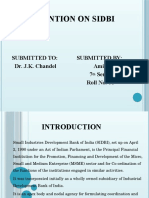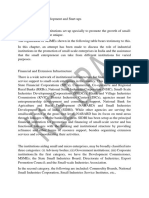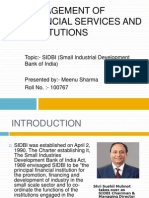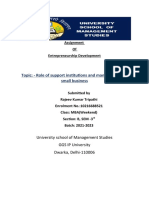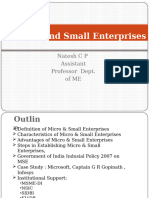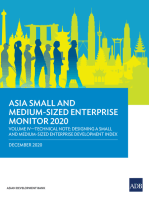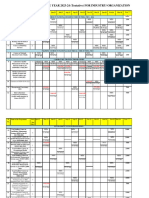Ijmte - Jan 2019.2
Ijmte - Jan 2019.2
Uploaded by
adarshvashishthCopyright:
Available Formats
Ijmte - Jan 2019.2
Ijmte - Jan 2019.2
Uploaded by
adarshvashishthOriginal Title
Copyright
Available Formats
Share this document
Did you find this document useful?
Is this content inappropriate?
Copyright:
Available Formats
Ijmte - Jan 2019.2
Ijmte - Jan 2019.2
Uploaded by
adarshvashishthCopyright:
Available Formats
International Journal of Management, Technology And Engineering ISSN NO : 2249-7455
Small Industrial Development Bank of India (SIDBI): Its role in
Financing and Development of Industries
* MNN Appaji, # J Krishnam Raju
*Assistant Professor, AKNU Campus, Tadepalligudem,
#Assistant Professor, AKNU Campus, Tadepalligudem
mnnappaji@gmail.com , kr.research@yahoo.com
Abstract
Small Industries Development Bank of India is an independent financial institution
aimed to aid the growth and development of micro, small and medium-scale enterprises
(MSME) in India. It was set up on April 2, 1990 through an act of parliament; it was
incorporated initially as a wholly owned subsidiary of Industrial Development Bank of
India. Currently the ownership is held by 33 Government of India owned and controlled
institutions Beginning as a refinancing agency to banks and state level financial
institutions for their credit to small industries, it has expanded its activities, including
direct credit to the SME through 100 branches in all major industrial clusters in India . It
is the Principal Financial Institution for the Promotion, Financing and Development of the
Micro, Small and Medium Enterprise (MSME) sector and for Co-ordination of the
functions of the institutions engaged in similar activities. The Role of SIDBI in Financing
and Development of industries in recent years is presented in this paper. This paper
Discuss the role of Direct and indirect financial Assistance schemes of SIDBI in industrial
development.
Keywords: SIDBI, Direct finance schemes, indirect finance schemes, MSME sector,
Small Scale Industries.
Introduction
The Small Industries Development Bank of India (SIDBI) was established as the
principal financial institution for the promotion, financing and development of industry in
the small scale sector and to co-ordinate the functions of the institutions engaged in the
promotion and financing or developing industry in the small scale sector and for matters
connected. Established on April 2, 1990 by an act of parliament Principal Development
Financial Institution for:
◦ Promotion
◦ Financing
◦ Development of MSME sector
◦ Co-ordination of Institutions involved in similar activities
SIDBI Head Office at Lucknow with 15 Regional Offices and Branch Offices in all the
States.
The business domain of SIDBI consists of MSMEs, which contribute significantly to the
national economy in terms of production, employment and exports.
1) Its Functions are:
A) SSI units for new/ expansion/ diversification/ modernization projects.
B) Marketing development projects which expand the domestic and international
marketability of SSI products.
C) Existing well run SSI units and ancillaries/ subcontracting units/ vendor units for
modernization and technology up gradation.
D) ) Infrastructure development agencies for developing industrial areas.
Volume IX, Issue I, JANUARY/2019 Page No:3838
International Journal of Management, Technology And Engineering ISSN NO : 2249-7455
2). It provides Foreign Currency Loan to:
A) Import equipment by existing export oriented SSIs and new units having definite
plans for entering export markets.
B) Execute confirmed export orders by way of pre-shipment credit/letter of credit
and provides post shipment facilities.
3). SIDBI’s Venture Capital Fund provides assistance to:
Small scale entrepreneurs using innovative indigenous technology and expertise
SIDBI refinances:
A) Loans granted for new SSI projects and for expansion, technology, up gradation,
modernization, quality promotion.
B) Loans sanctioned by SIDBI to small road transport operators, qualified
professionals for se employment, small hospitals and nursing homes, and to
promote hotel and tourism related activities.
Indian MSME Sector an overview
The MSME sector contributes to economic growth, entrepreneurship development,
financial inclusion and employment creation.
o No. of MSMEs – > 30 million
o Second largest source of employment - > 70 million
o Contributes 45% of manufacturing output and 40% of exports
Consistently higher growth – at > 11% even during crisis period – higher than industrial
and overall economic growth.
Classification of MSME’S
MANUFACTURING ENTERPRISES
(Investment in plant and machinery)
◦ Micro Enterprises up to Rs. 25 lakh
◦ Small Enterprises up to Rs. 500 lakh
◦ Medium Enterprises up to Rs. 1000 lakh
SERVICE ENTERPRISES
(Investment in equipment)
◦ Micro Enterprises up to Rs. 10 lakh
◦ Small Enterprises up to Rs. 200 lakh
◦ Medium Enterprises up to Rs. 500 lakh
Micro Finance sector
◦ Through Micro Finance Institutions
Business Model of SIDBI:
Addressing financial gaps and non-financial gaps with the purpose of facilitating higher
credit flow to the MSME sector and to make the sector strong, vibrant and competitive in
future.
Financial Gaps – Niche Products
Equity funding, mezzanine finance and risk capital.
Financing sustainable development - energy efficiency, Environment friendly
projects.
Up scaling receivable finance.
Secured Business Loan.
Financing service sector projects.
Continue indirect finance especially to
RRBs / NBFCs / Factoring companies / other channel partners like NEDFi, UCBs etc.
Non-Financial Gaps – Proposed Initiatives
Remove Informational Asymmetry
Small B. in – useful for entrepreneurs for setting up units
Volume IX, Issue I, JANUARY/2019 Page No:3839
International Journal of Management, Technology And Engineering ISSN NO : 2249-7455
Showcase technologies by research institutes
Guidance in project appraisal and disbursement
Preparing DPR for selected ideas etc.
Set up Credit Facilitation Centres
Guide entrepreneur’s on bank financing schemes and address queries of banks
Facilitating through Industry associations/SIDBI offices
Establishing marketing infrastructure – MSMEs
Exhibition centers
Capacity building of RRBs/UCBs
Cluster Development programmes.
Long term products of SIDBI
Energy efficiency, clean technologies, structured debt
Good potential for improving productivity and competitiveness through EE
measures
EE is significantly correlated to pollution and production of greenhouse gases
To promote clean technologies, CETPs, waste recycling & management in
MSME units/clusters
Structured debt/ tailor made approach to meet the special requirements of
MSMEs
Financial assistance at concessional/ competitive term.
Short term products of SIDBI
Receivable financing, trade financing
Financing of MSMEs receivables by discounting bills for covering their supplies
of raw material, components, sub-assemblies, job work etc., to Corporates.
Competitive rate of interest/discount rate based on rating
Average credit period up to 90 days.
Clean limit may also be considered subject to norms.
SIDBI Schemes and Initiatives for Finance and Development of industries :
1. Direct Credit Scheme (DCS)
Eligibility New or Existing units
Constitution Private / Public Ltd. Cos., / Partnership Firm and Proprietary Concern
Assistance Term Loan, WC Term Loan, Foreign Currency Term Loans
Minimum Loan Rs.50 Lakh for New Unit and Rs.25 lakh for Existing unit
Amount
Int Rate Linked to Rating and PLR.
Present PLR is 12.75% p.a.
Minimum 33% for New Units and 25% for Existing Units
Promoter’s
Contribution
DER Generally not exceeding 2:1
Repayment Period Max 8-10 years (incl. moratorium up 18 months).
Upfront fee Up to 2% of the term loan sanctioned.
2. Assistance for Energy Efficiency Projects
Parameter Norm
1 Minimum Assistance Generally not less than Rs.10 lakh
2 Minimum promoters contribution 25%
3 Debt Equity Ratio 2:1 (KfW) / 2.5:1 (JICA)
Volume IX, Issue I, JANUARY/2019 Page No:3840
International Journal of Management, Technology And Engineering ISSN NO : 2249-7455
4 Interest Rate Fixed/Floating, 11.50% to 13.00% p.a.
(50 bps lower than the normal rate)
5 Upfront fee Maximum up to 1% of the loan amount
6 Asset coverage 1.3 for manufacturing unit and 1.4 for service
sector.
7 Repayment period Need based. Normally, not to extend beyond 7
years.
3. CREDIT LINKED CAPITAL SUBSIDY SCHEME
Scheme of GOI operated through SIDBI as Nodal agency
Scheme valid for XI plan – 2007-2012 (since extended for XII plan 2012
onwards)
15% of the eligible investment in P & M for Technology Up gradation in select
sectors
Immediate lodging of subsidy claim upon implementation of the project
Subsidy to be adjusted against principal outstanding as and when funds released
by Govt.
4. Restructured TUF SCHEME FOR TEXTILE & JUTE INDUSTRIES
Scheme of GOI operated through SIDBI as Nodal agency
Scheme valid for XI plan – 2007-2012 (in the process of extending for XII plan
from 2012 onwards)
Textile and Jute industries in MSME sector are eligible.
The scheme will provide 5% interest subsidy.
It provides a CLCS of 15% for Textile Industry, 12% for Jute Industry and 20%
for power loom sector.
The scheme will provide 5% interest reimbursement plus 10% capital subsidy for
specified processing machinery in textiles.
5. CREDIT GUARANTEE TRUST FOR MICRO AND SMALL ENTERPRISES
Facilitates availment of credit by Micro/Tiny/Small and units engaged in IT based
activities from formal banking channel.
Maximum loan guaranteed by CGTMSE is Rs.100 lakh per SSI /Tiny unit
(Guarantee Cap Rs.50 lakh).
Annual Guarantee Fee at 1% p.a. (Concessional rates for women, units falling
under NER and micro enterprise.
6. Service Sector Finance
Eligible Activities (asset based/cash flow based)
Hotels, convention halls, shopping malls, hospitals, nursing homes etc.
Logistics, supply chain, material handling, warehousing, organised
retailing
Rent a cab, car/auto dealerships, workshops/service stations
IT and IT enabled services
Telecom, internet café, advertising, dry cleaning
Construction contractors, transport operators, courier services
Broadcasting, TV/Radio/Video programme production services
Eligibility New or Existing units
Constitution Private / Public Ltd. Cos., / Partnership Firm and Proprietary Concern
Intrest Rate Linked to Rating and PLR. Present PLR is 12.75 % p.a.
Minimum Cash flow backed: 33% (New)/ 25 %( Existing)
Promoter’s Asset backed: 25% (New)/ 20 %( Existing)
Contribution
Volume IX, Issue I, JANUARY/2019 Page No:3841
International Journal of Management, Technology And Engineering ISSN NO : 2249-7455
DER 2:1 for cash flow backed, 3:1 for asset backed
Repayment Max 8-10 years (incl. moratorium up 18 months).
Period
Upfront fee Up to 2% of the term loan sanctioned.
7. Infrastructure Finance
Eligible Activities
Transport – Roads, bridges, ports, airports, Urban public transport
Energy – Electricity generation/transmission/distribution, oil/gas pipelines,
Oil/Gas storage facilities
Water Sanitation – Waste management facilities, water supply pipelines,
treatment plants, irrigation, sewage collection/treatment facilities
Communication – Telecommunication (fixed network)/ telecommunication
towers.
Social and Commercial Infrastructure – Hospitals, hotels, industrial parks, SEZ,
Cold chains.
Infrastructure Finance
Eligibility New or Existing units
Constitution All forms of organizations such as Private / Public Ltd. Cos.,
Registered Societies/trusts, Govt. corporations/cooperative
entities
Intrest Rate In line with consortium lenders
Minimum Promoter’s 25% of project outlay
Contribution
DER 3:1
Repayment Period Max 10 years (incl. moratorium up to 3 years).
Upfront fee Up to 0.5% of the term loan sanctioned.
8. Privileged Customer Scheme (PCS)
Criteria:
For SIDBI’s existing well performing borrowers
Two year satisfactory payment track with at least one year principal repayment
track record with SIDBI.
Net profit in last two years of operation and should not be in default to any bank /
FI.
Should not have moved into stress category during the preceding one year from
the date of sanction.
Purpose:
Unforeseen/ emergent and bonafide business expenditure like:
Non project specific expenses like adding/ replacement of machinery, balancing
capital equipment, renovation/ additions to factory building, jigs /fixtures, computer
hardware/software, WC margin needs, marketing related expenses, setting up franchise,
brand building, execution of bulk orders, deposits for contracts, temporary shortage of
WC, etc.
Amount: 15% of Net Sales, maximum of Rs.100 lakh, annually.
Promoters Contribution : Nil
Volume IX, Issue I, JANUARY/2019 Page No:3842
International Journal of Management, Technology And Engineering ISSN NO : 2249-7455
DER: Not more than 2:1 for the company as a whole
Interest Rate: As per rating
Upfront fee: 0.5-1% of Term Loan sanctioned
Repayment Period: Max 5 years incl. moratorium of up to 1 year.
Charge on assets being created out of PCS
Extension of charge on existing immovable assets.
Overall asset coverage should not be less than 1.3 after availing the limit.
9. Growth Capital & Equity Assistance (GEMS)
To provide quasi equity/equity type of financial assistance/support to well-run
MSMEs to enable them to meet promoter contribution/DER/Security margin
requirement and to help them to scale up their operations.
Instrument – Subordinated debt, convertible debentures, convertible preference
shares, equity shares, etc.
Purpose :Expansion, Modernization and diversification, Marketing, R&D,
Product Development, Working Capital, any other expenditure required for
growth of the company
Investment Tenure - Horizon of about 5/7 years
Difficulties in Equity deals in MSMEs
More than 90% of the MSMEs are outside the purview of equity deals (being
prop./ partnerships)
Equity investment requires detailed Due-diligence (generally by qualified legal
attorneys and CAs) making the deals costlier for smaller MSMEs and taking very
long time to conclude
Valuation complexities. Negotiations to arrive at “Mutually Acceptable” value
further delays the process.
General aversion of MSMEs promoters in day-to-day interference in decision
making/ operations (which a typical equity investor seeks)
High return expectation (25-30%) from RISKY Equity investment does not suit a
typical MSME operating in conventional sector
Legal documentation expensive and complex and time consuming
Difficulty in Exit for the investor (IPO etc rare in MSMEs) Subordinate debt
Subordinated in ‘Repayments’ and ‘Security’ to senior lenders.
With or without conversion option - can be given to partnerships/ prop. concerns
Maximum amount - 1/3rd of net worth of the unit.
Moratorium – Min 3 years. Max 5 years. Total tenure 7-8 years
No collaterals insisted. Only residual charge on the business assets is obtained
and hence improves credit rating of secured loans. Simpler documentation.
10. Receivable Finance Scheme (RFS)
Flexible scheme, modifiable to suit the requirement of sellers and purchasers, if
so desired
Limit can be backed by collateral security or bill of exchange or even can be a
clean limit
RFS limit backed by Letter of Credit (LC discounting), directly to seller
RFS limit backed by collateral securities, directly to seller
Invoice discounting scheme for sellers
NTREES - Trade Receivables Engine for E-discounting (Prefix ‘N’ stands for
NSE and Suffix ‘S’ stands for SIDBI)
Direct discounting scheme (Equipment’s) for equipment purchasers
Volume IX, Issue I, JANUARY/2019 Page No:3843
International Journal of Management, Technology And Engineering ISSN NO : 2249-7455
Purpose To enable SSI / SME / Eligible Service sector units (including
construction / small road transport operators) selling
components, parts, sub-assemblies, services, etc. to Medium
& Large scale units realize their sale proceeds quickly
Limits are sanctioned to well establish industrial units using
Eligible borrowers components / parts / sub-assemblies / accessories / services
manufactured / provided by SSI / SME / Eligible Service
sector units. Either seller or Purchaser need to qualify as SSI /
SME / Service Sector unit
Norms Unexpired usance - Not more than 90 days
Facility without bills of exchange / LC backed receivables
can also be considered on the basis of merit.
The Various Financial Institutions provide finance to entrepreneurs:
1. Industrial Finance Corporation of India (IFCI): It was established in 1948 under an
Act of parliament with the object of providing medium and long-term credit to industrial
concerns in India.
2. The Industrial Development Bank of India (IDBI): It was established on 1st July
1964 under the Industrial Development Bank of India Act, as a wholly owned subsidiary
of the Reserve Bank of India. The most distinguishing feature of the IDBI is that it has
been assigned the role of the principle financial institution for co-ordinating, in
conformity with national priorities, the activities of the institutions engaged in financing,
promotion or developing industry. The IDBI has been assigned a special role to play in
regard to industrial development.
3. ICICI (The Industrial Credit and Investment Corporation of India): ICICI was
conceived as a private sector development bank in 1955 with the primary function of
providing development finance to the private sector.
A) Assisting in the creation, expansion and modernization of such enterprises.
B) Encouraging and promoting the participation of private capital, both internal and
external, in ownership of industrial investment and the expansion of investment
markets.
4. The National Bank for Agriculture and Rural Development(NABARD): Its
provides credit for promotion of agriculture, small-scale industries, cottage and village
industries, handicrafts and other rural crafts and other allied economic activities in rural
areas with a view to promoting integrated rural development and securing prosperity of
rural areas.
5. Industrial Investment Bank of India (IIBI): It was established in 1985 and it extends
loans and advanced to industrial concerns, underwrites stocks, shares, bonds, debentures
and provides guarantees for loans/deferred payment.
6. Export-Import Bank of India (EXIM): It was set up on January 1st , 1982 as the
principal financial institution for promotion and financing of India’s international trade.
Exim Bank finances exporters and importers, co-ordinates the working of institutions
engaged in financing export and import of goods and services, finances export- oriented
units and undertakes promotional activities necessary for international trade
7. Khadi and Village Industries Commission (KVIC): It is engaged in the development
of Khadi and village industries in rural areas.
8. National Small Industries Corporation Ltd (NSIC): It was set-up by the government
of India in 1955 with the objective of promoting and developing small-scale industries in
the country.
9. State Industrial Development Corporations (SIDCs): Its act for industrial
development and provide impetus to further investment in their respective States. SIDCs
provide assistance by way of term loans, underwriting and direct subscription to
shares/debenture and guarantees.
Volume IX, Issue I, JANUARY/2019 Page No:3844
International Journal of Management, Technology And Engineering ISSN NO : 2249-7455
10. State Small Industries Development Corporations (SSIDCs): It is State
Government undertakings, responsible for catering to the needs of the small, tiny and
cottage industries in the state/union Territories under their justification.
11.State Financial Corporation (SFCs): Its function with the objective of financing and
promoting small and medium enterprise for achieving balanced regional socio-economic
growth, catalyzing higher investment, generating greater employment opportunities and
widening the ownership base of industry.
2. Conclusion:
SIDBI plays an important role in financing and development of Industries. SIDBI
extends direct/indirect financial assistance to SSIs, assisting the entire spectrum of small
and tiny sector industries on All India basis. The range of assistance comprising
financing, extension support and promotional, are made available through appropriate
schemes of direct and indirect assistance for the various purposes like Setting up of new
projects, Expansion, diversification, modernization, technology up gradation, quality
improvement, rehabilitation of existing units, Strengthening of marketing capabilities of
SSI units. These developmental initiatives would not only address the emerging needs of
the sector, but also will create employment opportunities in this productive sector of the
economy.
References
[1] Parimal kumarsen A Study on role of SIDBI in financing small scale industries in India with special
Reference to Direct Finance Schemes, Department of commerce , The university of Burdwan, West
Bengal, March 2006.
[2] Satish Taneja, Entrepreneur Development, Himalaya Publishing House, First Edition, Reprint,
2012.
[3] Vasant Desai, The Dynamics of Entrepreneurial Development and Management, Himalaya
Publishing House, Fifth Revised Enlarged Edition, 2014.
[4] Poornima Charantimath, Entrepreneurship Development and Small Business Enterprises, Pearson
Education in South Asia, Tenth Impression, 2013.
[5] Srinivas K T, Role of Micro, Small and Medium Enterprises in Inclusive Growth, International
Journal of Engineering and Management Research, Vol. 3, Issue 4, August 2013, pp. 57 – 61.
[6] www.sidbi.in
[7] SmallB.in
[8] shodhganga.inflibnet.ac.in
[9] dcmsme.gov.in
[10] msme.gov.in
Volume IX, Issue I, JANUARY/2019 Page No:3845
You might also like
- SME Financing PPT DTDocument28 pagesSME Financing PPT DTdeepaktandon86% (7)
- Job Search - Find Your Dream Job With Guardian Jobs PDFDocument1 pageJob Search - Find Your Dream Job With Guardian Jobs PDFfisoxenekNo ratings yet
- CSR Report of WiproDocument31 pagesCSR Report of WiproNiraj Rai56% (9)
- Project Report For Printing PressDocument4 pagesProject Report For Printing PressSrikanta Sahu56% (9)
- First Interview SummaryDocument2 pagesFirst Interview Summaryapi-537611054No ratings yet
- Banking PPT SidbiDocument19 pagesBanking PPT SidbiMayank RajNo ratings yet
- Life Insurance CorporationDocument20 pagesLife Insurance CorporationRakeshChowdaryKNo ratings yet
- SIDBIDocument14 pagesSIDBIjyotigupta90No ratings yet
- What Is SIDBI ?Document8 pagesWhat Is SIDBI ?Kejal JainNo ratings yet
- SIDBIDocument23 pagesSIDBIamit33% (3)
- Small Industrial Development Bank of IndiaDocument21 pagesSmall Industrial Development Bank of IndiaRockyLagishettyNo ratings yet
- Role of Support Institutions and Management of Small BusinessDocument12 pagesRole of Support Institutions and Management of Small Businessneha sharma0% (1)
- Edm Chapter 2Document6 pagesEdm Chapter 2mohdayaz3550No ratings yet
- Attachment Financial InstitutionsDocument12 pagesAttachment Financial InstitutionsSanjeeva TejaswiNo ratings yet
- ACF Proposal DocumentDocument32 pagesACF Proposal DocumentIndranath MitraNo ratings yet
- M & E - Module 4Document28 pagesM & E - Module 4Mahi MaheshNo ratings yet
- GuestDocument12 pagesGuestkingztechnology11No ratings yet
- SIDBIDocument23 pagesSIDBINazia RahimanNo ratings yet
- Institutional Framework For Small Business DevelopmentDocument59 pagesInstitutional Framework For Small Business DevelopmentNishantpiyooshNo ratings yet
- SIDBI BankDocument35 pagesSIDBI BankrahsatputeNo ratings yet
- Financial InstitutionDocument17 pagesFinancial InstitutionAnika VarkeyNo ratings yet
- SME Financing: Submitted To Mr. S. Clement September 17,2010Document29 pagesSME Financing: Submitted To Mr. S. Clement September 17,2010scribddddddddddddNo ratings yet
- Shekhar Ibhrampurkar Summer Internship Project ReportDocument93 pagesShekhar Ibhrampurkar Summer Internship Project Reportayansur1986No ratings yet
- EDM Minor 2 Notes PDFDocument42 pagesEDM Minor 2 Notes PDFहर्ष वर्धन गुप्ताNo ratings yet
- Final SidbiDocument19 pagesFinal SidbiSahil TrehanNo ratings yet
- Growth of Micro, Small & Medium Enterprises in IndiaDocument19 pagesGrowth of Micro, Small & Medium Enterprises in Indiarishisingh9No ratings yet
- SIP SidbiDocument72 pagesSIP Sidbipalaksinghal100% (1)
- SidbiDocument16 pagesSidbiankushlunkad100% (2)
- Role of SIDBIDocument12 pagesRole of SIDBImonica_bhaskar1801No ratings yet
- ME Module 5Document54 pagesME Module 5Mohammed nadeerNo ratings yet
- ME Module 5 PDFDocument54 pagesME Module 5 PDFvinod kumarNo ratings yet
- Eds 4Document69 pagesEds 4YUVRAJ SINGH TAKNo ratings yet
- BMS Institute of Technology & Management Yelahanka Bangalore - 560064 Department of Information Science and EngineeringDocument9 pagesBMS Institute of Technology & Management Yelahanka Bangalore - 560064 Department of Information Science and EngineeringRuchitha VNo ratings yet
- Management of Financial Services and Institutions: Topic:-SIDBI (Small Industrial Development Bank of India)Document15 pagesManagement of Financial Services and Institutions: Topic:-SIDBI (Small Industrial Development Bank of India)seemagupta_11118018No ratings yet
- ME Module 5Document54 pagesME Module 5vinod kumarNo ratings yet
- Challenges Before Indian SME's & Consultancy Interventions NeededDocument44 pagesChallenges Before Indian SME's & Consultancy Interventions NeededRavi ManglaniNo ratings yet
- Sidbi Training 13.12.23-15.12.23Document45 pagesSidbi Training 13.12.23-15.12.23nikitasonkar92No ratings yet
- Functions of National Small Industries Corporation (NSIC)Document14 pagesFunctions of National Small Industries Corporation (NSIC)Naveen Jacob JohnNo ratings yet
- ME Module 5Document54 pagesME Module 5BHAVANA N S CSE-2020-24No ratings yet
- Chapter 1-Introduction "Good Things in Life Begin Small"Document40 pagesChapter 1-Introduction "Good Things in Life Begin Small"Suraj JadhavNo ratings yet
- NSIC: Functions and Support Provided by National Small Industries Corporation LTDDocument13 pagesNSIC: Functions and Support Provided by National Small Industries Corporation LTDsankasturkarNo ratings yet
- Government Schemes and Incentives For - pptx1Document26 pagesGovernment Schemes and Incentives For - pptx1Arjun VasudevNo ratings yet
- Report To Start IndustryDocument33 pagesReport To Start IndustryPuneet SinghNo ratings yet
- Institutional AssistanceDocument37 pagesInstitutional AssistanceVarun Dabir100% (1)
- Instutitional Service To Entrepreneur: RASHI SINGH (3227) Vishesh Jain (3242)Document46 pagesInstutitional Service To Entrepreneur: RASHI SINGH (3227) Vishesh Jain (3242)Vishesh JainNo ratings yet
- 5Document34 pages5shubham KumarNo ratings yet
- Small Industries Development OrganisationDocument22 pagesSmall Industries Development OrganisationShabaz Ahamed60% (5)
- Entrepreneurship Module 5Document30 pagesEntrepreneurship Module 5Rishika ParmarNo ratings yet
- Introduction To MSMeDocument4 pagesIntroduction To MSMeSyed SuhaibNo ratings yet
- Export-Import Bank of India: A Presentation AHMEDABAD: May 31, 2008Document28 pagesExport-Import Bank of India: A Presentation AHMEDABAD: May 31, 2008Anonymous DrSHPbseNo ratings yet
- Chapter 1-Introduction "Good Things in Life Begin Small"Document39 pagesChapter 1-Introduction "Good Things in Life Begin Small"Suraj JadhavNo ratings yet
- SidbiDocument3 pagesSidbiMegha ShyamNo ratings yet
- Assignment POof ED (Rajeev - 10216688521)Document11 pagesAssignment POof ED (Rajeev - 10216688521)Shreya PandeyNo ratings yet
- Industrial Development Bank of India LimitedDocument29 pagesIndustrial Development Bank of India LimitedJason RoyNo ratings yet
- Role of Institutional Support SystemDocument12 pagesRole of Institutional Support SystemAshi GargNo ratings yet
- Ritesh Jaiswal Roll No - 110Document16 pagesRitesh Jaiswal Roll No - 110riteshjaiswalNo ratings yet
- An Assignment On Small Industries Development Bank of India (SIDBI)Document13 pagesAn Assignment On Small Industries Development Bank of India (SIDBI)Pooja Gujarathi50% (2)
- ME Module 5 pptDocument54 pagesME Module 5 pptSiddesh Kumar N GNo ratings yet
- Institution Support To Start Up and Incentive For SSIDocument31 pagesInstitution Support To Start Up and Incentive For SSIShilpa SulekhNo ratings yet
- ED-Module 2Document15 pagesED-Module 2nichumon319No ratings yet
- Poe AnswersDocument3 pagesPoe AnswersFaisal PashaNo ratings yet
- MSMEDocument36 pagesMSMEBHANUPRIYANo ratings yet
- Public Financing for Small and Medium-Sized Enterprises: The Cases of the Republic of Korea and the United StatesFrom EverandPublic Financing for Small and Medium-Sized Enterprises: The Cases of the Republic of Korea and the United StatesNo ratings yet
- Asia Small and Medium-Sized Enterprise Monitor 2020: Volume IV: Technical Note—Designing a Small and Medium-Sized Enterprise Development IndexFrom EverandAsia Small and Medium-Sized Enterprise Monitor 2020: Volume IV: Technical Note—Designing a Small and Medium-Sized Enterprise Development IndexNo ratings yet
- Role of SidbiDocument51 pagesRole of SidbiadarshvashishthNo ratings yet
- JETIR1908405Document10 pagesJETIR1908405adarshvashishthNo ratings yet
- I Man Dts and Ratings FinancialsDocument105 pagesI Man Dts and Ratings FinancialsadarshvashishthNo ratings yet
- 7.15 SIDBI 2025 Series I of FY 2022 23 IM&TSDocument66 pages7.15 SIDBI 2025 Series I of FY 2022 23 IM&TSadarshvashishthNo ratings yet
- ProjectDocument6 pagesProjectadarshvashishthNo ratings yet
- Chapter 3 (Tan&Lee) (Autosaved)Document67 pagesChapter 3 (Tan&Lee) (Autosaved)Dewi HazarNo ratings yet
- IFRS For SMESDocument52 pagesIFRS For SMESRiaz Ladha100% (1)
- FA Chapter 11 Group Accounts Consolidated Balance SheetDocument50 pagesFA Chapter 11 Group Accounts Consolidated Balance Sheetabhinand67% (3)
- Analysis of Bop Position of India in Last 10 Years: Ritika Kamboj Mba Finance Sec A A001110719068Document7 pagesAnalysis of Bop Position of India in Last 10 Years: Ritika Kamboj Mba Finance Sec A A001110719068Simran chauhanNo ratings yet
- St. Vincent College of CabuyaoDocument68 pagesSt. Vincent College of CabuyaoArthur V. GerillaNo ratings yet
- Project ForexDocument63 pagesProject ForexRitesh koliNo ratings yet
- SME Presentation FinalDocument38 pagesSME Presentation Finalmuid0062No ratings yet
- Evaluation 4Document3 pagesEvaluation 4Cassidy ZapantaNo ratings yet
- Weaving 5th SemesterDocument35 pagesWeaving 5th SemesterAhmad ButtNo ratings yet
- Chapter 11 - Project Risk Management PDFDocument87 pagesChapter 11 - Project Risk Management PDFHENDRI MAHEND100% (2)
- Exercise 6Document4 pagesExercise 6Tania MaharaniNo ratings yet
- Store Design ObjectivesDocument22 pagesStore Design ObjectivesLaura MartinNo ratings yet
- Unit 2 HR Planning and Job AnalysisDocument18 pagesUnit 2 HR Planning and Job AnalysisCharlie PuthNo ratings yet
- Distributor AgreementDocument4 pagesDistributor AgreementbharathNo ratings yet
- Investment Bankers and Scope FinalDocument48 pagesInvestment Bankers and Scope FinalAkash Gupta0% (1)
- 5 Tools To Gain Competitive AdvantageDocument40 pages5 Tools To Gain Competitive Advantagegandalfa12100% (1)
- Project Report of A BROILER FARMINGDocument6 pagesProject Report of A BROILER FARMINGMANAS KUMAR SAHUNo ratings yet
- Business Process Reengineering: A Recent Review: December 2014Document29 pagesBusiness Process Reengineering: A Recent Review: December 2014Abeni KassNo ratings yet
- Topic 8 - Firms in Competitive Markets PDFDocument32 pagesTopic 8 - Firms in Competitive Markets PDF郑伟权No ratings yet
- Company Law Part B Guideline AnswerDocument14 pagesCompany Law Part B Guideline Answertior9340No ratings yet
- Yamini Prasad CV PDFDocument2 pagesYamini Prasad CV PDFjattinNo ratings yet
- MKT 101-2123 (4) Final Assignment - Spring 2020Document4 pagesMKT 101-2123 (4) Final Assignment - Spring 2020Intishar AvikNo ratings yet
- OSHJ-CoP-01 Risk Management and Control Version 1 EnglishDocument15 pagesOSHJ-CoP-01 Risk Management and Control Version 1 EnglishsajinNo ratings yet
- BIS Training - Calender - Industry - 2023-24Document7 pagesBIS Training - Calender - Industry - 2023-24Dinesh SharmaNo ratings yet
- KELOMPOK 10 StramenDocument7 pagesKELOMPOK 10 StramenhajarawNo ratings yet
- Presentation 7Document14 pagesPresentation 7Falguni ShomeNo ratings yet









